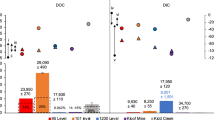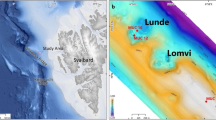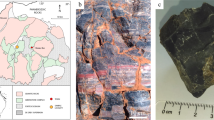Abstract
ABYSSAL brine springs at the base of the Florida Escarpment in the Gulf of Mexico (∼3,280 m, 26° O2' N 84° 55' W) are surrounded by communities of abundant heterotrophic organisms1–4 and carbonate-cemented crusts5. These organisms are apparently supported by local chemosynthetic primary production because the 13C content of their tissues is lower than that found in typical photosynthetically fixed organic carbon6, and the enzymes associated with chemosynthetic metabolism are present in their tissues7,8. Here we report that fossil methane is the dominant source of carbon found in living tissues and recent authigenic carbonate minerals associated with abyssal brine seeps at the base of the Florida Escarpment. Most organic carbon and authigenic carbonates adjacent to the seeps contain progressively less modern carbon as their 13C contents approach that of methane carried in the brine. Incorporation of fossil methane (⩾=1.3% modern carbon) into living tissues and carbonate cements results in recently formed materials which are depleted in 14C. Therefore, 14C cannot be used to indicate the age of authigenic materials produced at the pore-water-seepage environments that speckle the continental margins of the world.
This is a preview of subscription content, access via your institution
Access options
Subscribe to this journal
Receive 51 print issues and online access
$199.00 per year
only $3.90 per issue
Buy this article
- Purchase on Springer Link
- Instant access to full article PDF
Prices may be subject to local taxes which are calculated during checkout
Similar content being viewed by others
References
Paull, C. K. et al. Science 226, 965–967 (1984).
Hecker, B. Bull. biol. Soc. Wash. 6, 465–473 (1985).
Commeau, R. F., Paull, C. K., Commeau, J. A. & Poppe, J. Earth planet. Sci. Lett. 82, 62–73 (1987).
Paull, C. K. & Neumann, A. C. Geology 15, 545–548 (1987).
Neumann, A. C. et al. Bull. Am. Ass. Petrol. Geol. 72, 228 (1988).
Paull, C. K., Jull, A. J. T., Toolin, L. J. & Linick, T. Nature 317, 709–711 (1985).
Cavanaugh, C. M., Levering, R. R., Maki, J. S., Mitchell, R. & Lidstrom, M. E. Nature 325, 346–348 (1987).
Cary, C., Fry, B., Feldbeck, H. & Vetter, R. D. Mar. Biol. 3, 411–418 (1989).
Jannasch, H. W. in Hydrothermal Processes at Seafloor Spreading Centers (eds Rona, P. A., Bostrom, K., Laubier, L. & Smith, K. L.) 677–709 (Plenum, New York, 1984).
Brooks, J. M. et al. Science 238, 1138–1141 (1987).
Chanton, J. P., Martens, C. S. & Paull, C. K. Eos 69, 1118 (1988).
Chanton, J. P., Martens, C. S. & Paull, C. K. Eos 68, 1701 (1987).
Childress, J. J. et al. Science 233, 1306–1308 (1986).
Linick, T. W., Jull, A. J. T., Toolin, L. J. & Donahue, D. J. Radiocarbon 28, 522–533 (1986).
Martens, C. S. & Berner, R. A. Science 185, 1167–1169 (1974).
Broecker, W. S. & Peng, T.-H. Tracers in the Sea 306–311 (Eldigio, New York, 1982).
Berger, W. H. & Johnson, R. F. Earth planet. Sci. Lett. 41, 223–227 (1978).
Ericson, D. B. & Wollin, G. Micropaleontology 2, 257–270 (1956).
Normark, W. R. et al. in Init. Rep. DSDP Leg 96. 425–436 (1983).
Hathaway, J. C. & Degens, E. T. Science 165, 690–692 (1969).
Eadie, B. J., Jeffrey, L. M. & Sackett, W. H. Geochem. cosmochlm. Acta 42, 1265–1269 (1978).
Author information
Authors and Affiliations
Rights and permissions
About this article
Cite this article
Paull, C., Martens, C., Chanton, J. et al. Old carbon in living organisms and young CaC03 cements from abyssal brine seeps. Nature 342, 166–168 (1989). https://doi.org/10.1038/342166a0
Received:
Accepted:
Issue Date:
DOI: https://doi.org/10.1038/342166a0
This article is cited by
-
Impact of North Korean nuclear weapons test on 3 September, 2017 on inland China traced by 14C and 129I
Journal of Radioanalytical and Nuclear Chemistry (2018)
-
Heterogeneous energetic pathways and carbon sources on deep eastern Mediterranean cold seep communities
Marine Biology (2010)
-
Carbon isotopes in mollusk shell carbonates
Geo-Marine Letters (2008)
-
Isotopic evidence for methane-based chemosynthesis in the Upper Floridan aquifer food web
Oecologia (2006)
-
Beggiatoa in microbial mats at hydrocarbon vents in the Gulf of Mexico and Warm Mineral Springs, Florida
Geo-Marine Letters (1994)
Comments
By submitting a comment you agree to abide by our Terms and Community Guidelines. If you find something abusive or that does not comply with our terms or guidelines please flag it as inappropriate.



